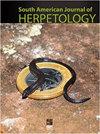Locomotion and Biomechanical Adaptations in Hind Limb Muscles of Three Mexican Anuran Species
IF 0.7
4区 生物学
Q4 ZOOLOGY
引用次数: 0
Abstract
Abstract. Anurans are anatomically built for jumping, requiring the muscles to contract to generate sufficient mechanical force to launch their bodies. A lot of energy is needed in the hind limbs, where the majority of the force is produced, whereas the front legs and both girdles serve mainly to support the frog's weight at rest as well as to absorb the shock of landing. Different species of anurans have different locomotion mechanisms, evidenced by comparing the mechanical contractile properties of hind limb muscles. In this study, we compared two muscles in arboreal (Agalychnis dacnicolor), terrestrial (Incilius marmoreus), and aquatic (Lithobates sierramadrensis) species of Mexican anurans. We performed low frequency in situ stimulations of the muscles and found that A. dacnicolor showed higher stresses than L. sierramadrensis and I. marmoreus in the two studied muscles, the cruralis and the gastrocnemius. Regarding the cruralis, the stress generated by the aquatic and terrestrial anurans was up to 23% less than that generated by the arboreal anuran. There was also a difference of up to 30% in the ratio of performance between low frequencies and twitch in L. sierramadrensis compared to the other anurans. These differences in muscle physiology suggest adaptive differences among species, although more comprehensive studies are needed to corroborate this hypothesis.三种墨西哥无尾猿后肢肌肉的运动和生物力学适应
摘要Anurans在解剖学上是为跳跃而建的,需要肌肉收缩以产生足够的机械力来启动身体。后肢需要大量的能量,大部分力都是在后肢产生的,而前腿和两条腰带主要用于支撑青蛙休息时的重量以及吸收落地时的冲击。通过比较后肢肌肉的机械收缩特性,可以证明不同种类的无尾类有不同的运动机制。在这项研究中,我们比较了树栖(Agalychnis dacnicolor)、陆生(Incilius marmoreus)和水生(Lithobates sieramadrensis)墨西哥无尾类的两块肌肉。我们对肌肉进行了低频原位刺激,发现A.dacnicolor在两块研究的肌肉,即小腿和腓肠肌中表现出比L.sieramadrensis和I.marmoreus更高的应力。关于足底,水生和陆生无尾虫产生的压力比树栖无尾虫少23%。在低频和抽搐之间的表现比率上,与其他无症状者相比,西氏乳杆菌也有高达30%的差异。这些肌肉生理学的差异表明了物种之间的适应性差异,尽管还需要更全面的研究来证实这一假设。
本文章由计算机程序翻译,如有差异,请以英文原文为准。
求助全文
约1分钟内获得全文
求助全文
来源期刊
CiteScore
1.50
自引率
0.00%
发文量
10
期刊介绍:
The South American Journal of Herpetology (SAJH) is an international journal published by the Brazilian Society of Herpetology that aims to provide an effective medium of communication for the international herpetological community. SAJH publishes peer-reviewed original contributions on all subjects related to the biology of amphibians and reptiles, including descriptive, comparative, inferential, and experimental studies and taxa from anywhere in the world, as well as theoretical studies that explore principles and methods.

 求助内容:
求助内容: 应助结果提醒方式:
应助结果提醒方式:


